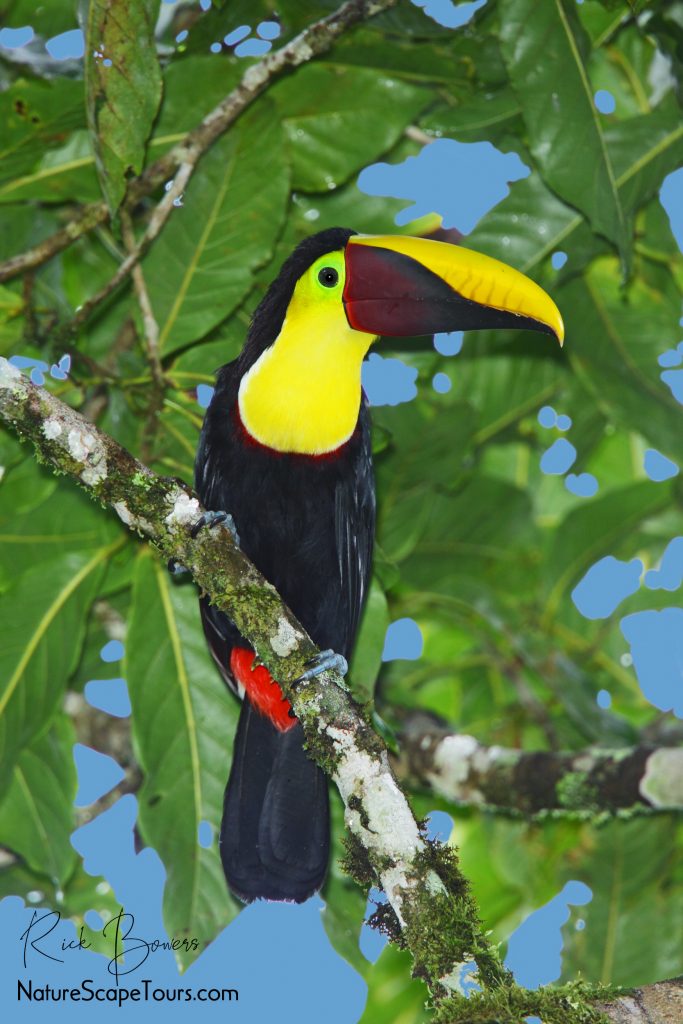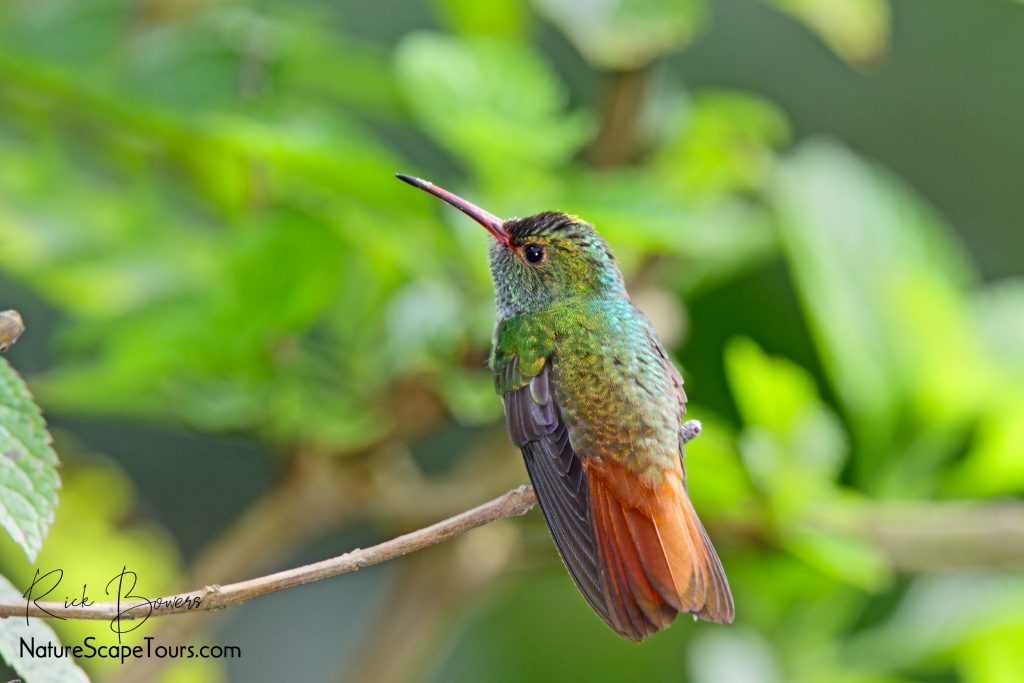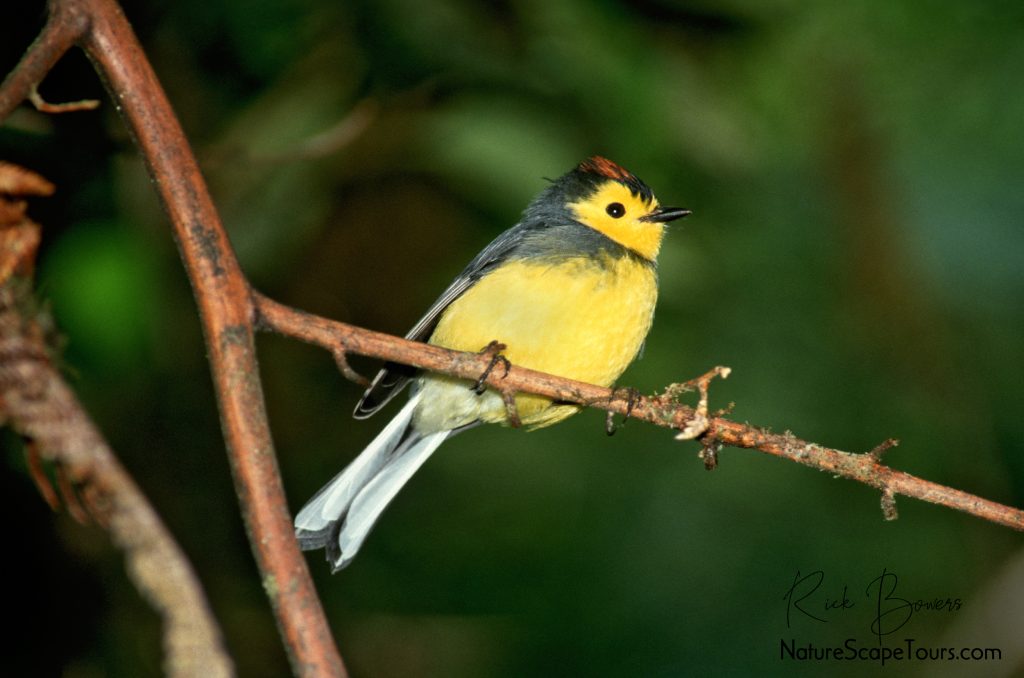Costa Rica Toucans and Hummingbirds 2019
| Registration |
Rick Bowers leads
March 9-24, 2019
The name Costa Rica conjures up visions of miles of sun-drenched beaches , exotic plant and animal life and steamy rainforests. Lush jungles, teak and coffee plantations, cattle ranches, banana and cacao plantations, and active volcanoes exemplify the diversity of this Central American country. From cloud forest sub-alpine dwarf vegetation to tropical beach, you’ll experience a dizzying array of climatic conditions during the course of our tour. Costa Rica is an exceptional place to study plant, butterfly and bird life (with approximately 12,000, 1,000, and 850 species known respectively). The climate is gentle, ranging from warm and humid (80º – 90º) in the coastal low lands to cool early morning temperatures (40º) near 10,000 feet. Our itinerary provides us visits to many of the country’s best birding areas. Exceptional natural beauty, combined with tropical birdlife famous the world over, make our Costa Rican adventure a birding and photographer’s dream.
We start our trip with two nights at the world-famous Monteverde Cloud Forest searching for Black Guan, Green Hermit, Lesser (Green) Violetear, Resplendent Quetzal, Lesson’s (Blue-crowned) Motmot, Blue-throated (Emerald) Toucanet, Yellowish Flycatcher, Three-wattled Bellbird, Slaty-backed Nightingale-Thrush, and Slate-throated Redstart.
From Monteverde we travel to the Arenal Observatory Lodge for two nights. The feeders at the lodge offer some great photo opportunities. Expected species include Crested Guan, Great Curassow, White-necked Jacobin, Violet-headed and Rufous-tailed Hummingbirds, Gartered (Violaceous) Trogon, Broad-billed Motmot, Yellow-throated (Chestnut-mandibled) and Keel-billed Toucans, Red-lored Parrot, Dusky Antbird, Streak-headed Woodcreeper, Scale-crested Pygmy-Tyrant, Gray-capped Flycatcher, Stripe-breasted Wren, Costa Rica’s National bird the Clay-colored Thrush, Black-striped Sparrow and Montezuma Oropendola.
Next we move to the Atlantic Lowland Rainforest and the Laguna del Lagartos Lodge. This lodge offers opportunities to photograph Keel-billed Toucans, Yellow-throated Toucans, and Brown-hooded Parrots like no other location! Of course the feeders and adjacent trails attract many other species including Pale-vented Pigeon, Groove-billed Ani, Rufous-tailed Hummingbird, Russet-naped (Rufous-necked) Wood-Rail, Black-headed Trogon, Ringed and Amazon Kingfishers, Hoffman’s Woodpecker, Red-lored Parrot, and Spot-breasted Wren. Another very special opportunity here is the dedicated King Vulture blind. Rather than seeing King Vultures soaring hundreds of feet up or perched a half mile away, you get to watch them feed just 20 feet away! An astounding experience and the photo ops are fabulous!
From Laguna Lagartos we travel east to Sarapiqui. La Quinta de Sarapiqui Lodge offers wonderful feeders as well as access to a huge variety of subtly different habitats that harbor a wealth of birds, mammals, and plants! Near the lodge we will look for Gray-headed Chachalaca, Bronzy and Long-billed Hermit, Purple-crowned Fairy, Spectacled Owl, Gartered (Violaceous) Trogon, Collared Aracari, Orange-chinned Parakeet, Streak-headed Woodcreeper, Gray-capped Flycatcher, and Orange-billed Sparrow. At the nearby La Selva Organization for Tropical Studies research station we will walk into a 4000 acre tract of undisturbed lowland rain forest to explore for a whole other set of forest birds.
From the Atlantic lowlands we travel uphill to Savegre Lodge at 7000 feet. With this geographic and elevational change the plant and animal life changes completely. The warm tropics give way to very cool mornings and very pleasant days searching the moss draped woodlands for Black Guan, Spotted Wood-Quail, Talamanca Hummingbird, White-throated Mountain-Gem, Resplendent Quetzal, Collared Trogon, Sulphur-crowned Parakeet, Spot-crowned Woodcreeper, Mountain Elaenia, Yellowish Flycatcher, a slew of thrushes, Gray-breasted Wood-Wren, Yellow-thighed Finch and Collared Redstart.
We return to San Jose for a last night in fabulous Costa Rica and the end of a memorable trip.
9 March, Day 1: Arrival in San Jose. Arrive San Jose, Costa Rica, at the Juan Santamaría International Airport (SJO) and transfer to nearby Hotel Bougainvillea. Those arriving in San Jose today will be met at the airport by Rick Bowers. You will be met at the nearest point of public entry. The airport is small, and our meeting location is obvious. Those arriving in Costa Rica earlier can check in at the hotel in the afternoon hours. NatureScape Tours will assist you with your travel arrangements in any way we can. Overnight San Jose.
10 March, Day 2: San Jose to Monteverde. After an early breakfast we start our drive to Monteverde. We leave the middle elevations of San Jose and drop toward the Pacific coast for a short time and then back inland and up a unique mountain road to Monteverde. Along the way we will start to add birds and mammals to our list. Turquoise-browed Motmot, Hoffman’s Woodpecker, White-fronted Parrot, White-throated Magpie-Jay, and Rufous-capped Warbler are all common along the drive up to Monteverde. We will arrive in Monteverde in time for lunch.

With the red crown and nape leading into gold this is an intergrade Hoffman’s x Red-crowned Woodpecker.
The afternoon will be spent at the Monteverde Cloud Forest Reserves hummingbird gallery. This is an exciting place and you should expect at least 7 species of dazzling hummingbirds here with highlights being the endemic Coppery-headed Emerald, the near endemic Magenta-throated Woodstar, Purple-throated Mountain-Gem, Stripe-tailed Hummingbird and the enormous Violet Sabrewing. Overnight Fonda Vela
11 March, Day 3: Monteverde. This morning we will walk some of the trails in the reserves at Monteverde. The cloud forest here offers an amazing variety of birds. Starting with the spectacular Resplendent Quetzal, Black Guan, Orange-bellied Trogon, Prong-billed Barbet, Ruddy Treerunner, Red-faced Spinetail, the reclusive Gray-breasted Wood-Wren, Common Chlorospingus , and Costa Rican Warbler.
12 March, Day 4: Monteverde to Arenal National Park. In the afternoon we will transfer to the Caribbean foothills of the Arenal Volcano area. Here we’ll spend an amazing four nights at a four bedroom rental home that will be our exclusively.
We stop at La Virgen del Socorro on the way to Arenal Observatory Lodge and walk a birdy road, watching overhead for hawks. This wet-forest gorge may produce Smoky-brown Woodpecker, Olivaceous Woodcreeper, Red-faced Spinetail, Zeladon’s Antbird, Nightingale Wren, Yellow-margined and Slaty-capped Flycatchers, Scale-crested Pygmy-Tyrant, Pale-vented Robin, Slaty-backed Nightingale-Thrush, Slate-throated and Collared Redstarts and Emerald, Bay-headed and Black-and-yellow Tanagers. At La Paz Waterfall we should spot a Torrent Tyrannulet. Eventually we arrive at Arenal National Park. Night Arenal.
13-15 March, Day 5-7: Arenal National Park. — We’ll add to our list on the grounds of Arenal Observatory Lodge, but much of one day will be spent in Arenal National Park. Some of our target birds are Gray-headed Chachalaca, Crested Guan, Great Curassow, Red-billed Pigeon, Green-breasted Mango, Slaty-tailed Trogon, Black-cheeked Woodpecker, Buff-throated Foliage-gleaner, Fasciated Antshrike; Dusky, Spotted and Bicolored Antbirds, Thicket Antpitta, Yellow Tyrannulet, Yellow-bellied Elaenia, Cinnamon Becard, White-throated Magpie-Jay.
Over the next two days we will spend time photographing at the Lodge feeders and grounds. A nearby Herpetarium should offer some great photo ops. We will explore more of the National Park also. Overnight Arenal.
16-17 March, Day 6-7: Laguna del Lagarto. After a bit of birding around Arenal will make our way to Laguna del Largotos near the Nicaragua border. This lodge and its blinds offer some of the best photo opportunities for Keel-billed and Yellow-throated (Chestnut-mandibled) Toucans, Brown-hooded Parrots, and Montezuma Oropendola. One blind is specifically built to photograph vultures and the king of the show is, of course, the King Vulture. Most views of King Vultures are of birds soaring at great heights or perch on trees a quarter of a mile away. Not here, the birds are just twenty feet away feeding on carrion and oblivious to our presence! In addition there are many smaller birds to photograph at various feeders and even macro opportunities of frogs and snakes for those who wish.
We will have most of two days to enjoy numerous photo ops at this wonderful lodge!
Here is a short video about some of the animals and activities at Laguna del Lagarto Lodge.
18 March, Day 8: Laguna del Lagartos to La Quinta de Sarapiqui. After a last morning photographing toucans and parrots we will head to the Caribbean lowlands near the town of Sarapiqui. This is one of the most biodiverse areas of Costa Rica and we will sample many different habitats and their many inhabitants.
In the afternoon we will visit another location that is set up for bird photography. Feeders attract a good variety including thrushes, tanagers, honeycreepers, oropendolas, hummingbirds, motmots, and aracaris. The question here is – where do I point my camera?
19 March, Day 9: Sarapiqui area. This morning we will make a short drive to a farm where the owner has acclimated Great Green and Scarlet Macaws that nest on the farm to come in to natural perches. In addition to perched shots we should have opportunities at flight shots of these wonderful birds. What a morning it will be!
This afternoon we will visit the world famous La Selva Organization for Tropical Studies Field Station. This is a huge property with second growth and untouched primary rain forest. The frequency of researchers walking the trails has led to many birds that are often hard to see being used to people and very cooperative. The parking lot is often hard to get away from as there are birds going everywhere!
20 March, Day 10: La Selva OTS Station, La Quinta de Sarapiqui to Savegre Lodge. Our lodge has some wonderful feeders and we will spend time this morning doing setups of the many birds coming to the feeders, both fruit and hummingbird.
Along our route to Savegre we will stop at a hummingbird garden and a number of other places in hopes of picking up some new species as we travel. This will be one of our longest travel days going from the Caribbean lowlands to high in the central mountains of Costa Rica.
Night Savegre Lodge
21 March, Day 11: Savegre Lodge. At Sevegre we have climbed from a few hundred feet above sea level to about 7,000 feet altitude. The climate and the birdlife have definitely changed from the Caribbean lowlands. Depending on our arrival time we may have time to look around for birds before dinner or not. Either way we may go out looking for nightbirds if we can stay awake!
22 March, Day 12: Savegre Lodge. In the cool morning we’ll observe Slaty Flowerpiercers by our cabins, and the feeders will be busy with Lesser (Green) Violet-ears, Gray-tailed and White-bellied Mountain-gems, Talamanca (Magnificent), Fiery-throated Hummingbird and Scintillant Hummingbirds. We’ll have a search for the mystical Resplendent Quetzal. More possibilities are Black Guan, Ruddy Pigeon, Collared Trogon, Golden-olive Woodpecker, Spot-crowned Woodcreeper, Spotted Barbtail, Ruddy Treerunner, Buffy Tuftedcheek, Lineated Foliage-gleaner, Dark Pewee; Boat-billed, Golden-bellied, Yellowish and Tufted Flycatchers. We’ll find Gray-breasted Wood-Wren, Black-capped Flycatcher, Sooty Robin, Flame-throated Warbler. Our nightjar and pygmy-owl search will be conducted after supper. Overnight: Savegre Lodge.
23 March, Day 13: Cerro de la Muerte to San Jose. On the Tower Road at over 11,000 feet we will walk slowly in the thin mountain air. Fiery-throated and Volcano Hummingbirds, Timberline Wren and Peg-billed Finch are our targets in this bleak and often foggy paramo habitat. La Georgina Restaurante on the highway will be a welcome stop for a hot drink and a bird or two. Overnight: San Jose.
24 March: Day 15: Flights home. Please plan your flight home anytime this morning out of Juan Santamaría International Airport. Rick will drive everyone to the airport for your flights home. In addition to your luggage, you should have loads of great memories and tons of images to enjoy!
TOUR PRICING AND INFORMATION








